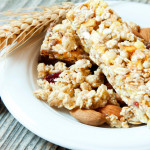 Have you ever been told to get more fiber in your diet but aren’t sure how? You may have noticed dietary fiber listed under total carbohydrate on the Nutrition Facts Label and wondered how it’s different from other carbohydrates. What makes fiber so special?
Have you ever been told to get more fiber in your diet but aren’t sure how? You may have noticed dietary fiber listed under total carbohydrate on the Nutrition Facts Label and wondered how it’s different from other carbohydrates. What makes fiber so special?
What is fiber and why do I need it?
Fiber is a type of carbohydrate found in fruits, vegetables, grains, beans, and nuts. It helps move food through the digestive system, which prevents you from getting constipated. Certain types of fiber can also help to relieve and prevent diarrhea or soft stools. Since fiber gets digested in a different way than other carbohydrates, it may not give you as many calories as other types of carbohydrates do and it helps you feel full after eating it. Fiber also helps get rid of LDL (“bad”) cholesterol in your body, and can lower your risk for cancer and heart disease.
There are two types of fiber: soluble and insoluble. If you regularly eat different kinds of fruits, vegetables, and whole grains, you are likely getting each kind of fiber. Both types of fiber are good for you and are associated with health benefits.
What foods have fiber in them?
Fiber gives plants their structure so all foods that come from plants contain some fiber, although some have more than others. Here are some top fiber-containing foods:
- Legumes such as lentils, beans, and peas
- Whole grains such as barley, oats, brown rice, and whole wheat products (bread, pasta, crackers)
- Nuts, including almonds, peanuts, and pistachios
- Whole wheat cereals such as bran flakes and shredded wheat
- Fruits such as apples (with skin), pears (with skin), oranges, and bananas
- Berries such as blueberries, blackberries, and strawberries
- Vegetables including broccoli, Brussels sprouts, and carrots
- Starchy vegetables such as corn and potatoes with skin
The list of foods above might sound familiar if you’ve ever been given suggestions for a healthy, balanced diet! Examples of foods that do not contain much fiber include: animal products such as meat, fish, cheese, yogurt, and milk, highly processed foods such as white bread, chips, candy, and sugary foods and drinks. There are also products out there that have extra fiber added such as Fiber-One® bars and Activia® yogurt with fiber. While these products can be a healthy part of a balanced diet, try to get your fiber mainly from natural plant sources.
How much fiber do I need?
- Teen boys- should get about 31 grams of fiber each day
- Teen girls- should get about 26 grams of fiber each day
How can you do this? It’s not as hard as you might think! Here is a sample day that would give you more than 30 grams of fiber:
Breakfast:
- 1 cup mini shredded wheat cereal with milk
- 1/2 cup blueberries
Snack:
- 1 oz almonds
Lunch:
- 2 slices of whole grain bread with turkey, lettuce, and tomato, glass of milk
Snack:
- Apple with peanut butter
Dinner:
- Black bean burrito with brown rice, salsa, and cheese
- Small spinach salad
Will eating fiber-rich foods make me gassy or constipated?
Many foods that are part of a healthy diet such as veggies, fruits and whole grains naturally mix with the bacteria in your stomach to cause a reaction which makes gas. You can usually avoid this by increasing your fiber intake slowly, over time. If you still find it to be a problem, you can talk to your health care provider about taking an over-the-counter enzyme before meals, such as Beano®. Eating too much fiber too quickly can give you a stomach ache so make sure to start slow and drink plenty of water.
Source: Read Full Article
